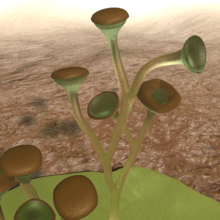Cooksonia (plant)
|
Cooksonia Temporal range: Wenlock–Early Devonian |
|
|---|---|
 |
|
| A cartoon of Cooksonia, reconstructed with non-photosynthetic axes, dependent on its gametophyte, as per Boyce (2008) | |
| Scientific classification | |
| Kingdom: | Plantae |
| Division: | Tracheophytes |
| Genus: |
†Cooksonia Lang 1937 emend. Gonez & Gerrienne 2010 non Druce 1905 |
| Species | |
|
|
Cooksonia is an extinct grouping of primitive land plants. The earliest Cooksonia date from the middle of the Silurian (the Wenlock epoch); the group continued to be an important component of the flora until the end of the Early Devonian, a total time span of 433 to 393 million years ago. While Cooksonia fossils are distributed globally, most type specimens come from Britain, where they were first discovered in 1937.Cooksonia includes the oldest known plant to have a stem with vascular tissue and is thus a transitional form between the primitive non-vascular bryophytes and the vascular plants.
Only the sporophyte phase of Cooksonia is currently known (i.e. the phase which produces spores rather than gametes). Individuals were small, a few centimetres tall, and had a simple structure. They lacked leaves, flowers and roots — although it has been speculated that they grew from a rhizome that has not been preserved. They had a simple stalk that branched dichotomously a few times. Each branch ended in a sporangium or spore-bearing capsule. In his original description of the genus, Lang described the sporangia as flattened, "with terminal sporangia that are short and wide", and in the species Cooksonia pertoni "considerably wider than high". A 2010 review of the genus by Gonez and Gerrienne produced a tighter definition, which requires the sporangia to be more-or-less trumpet-shaped (as in the illustration), with a 'lid' or operculum which disintegrates to release the spores.
Specimens of one species of Cooksonia have a dark stripe in the centre of their stalks, which has been interpreted as the earliest remains of water-carrying tissue. Other Cooksonia species lacked such conducting tissue.
...
Wikipedia
